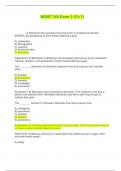MGMT 340 Exam 2 (Ch 7)
________ is defined as the processes that account for an individual's intensity,
direction, and persistence of effort toward attaining a goal.
A) Leadership
B) Management
C) Learning
D) Emotional labor
E) Motivation
Explanation: E) Motivation is defined as the processes that account for an individual's
intensity, direction, and persistence of effort toward attaining a goal.
The ________ dimension of motivation measures how long a person can maintain
effort.
A) direction
B) persistence
C) intensity
D) knowledge
E) experience
Explanation: B) Motivation has a persistence dimension. This measures how long a
person can maintain effort. Motivated individuals stay with a task long enough to
achieve their goal.
The ________ element of motivation describes how hard a person tries.
A) intelligence
B) experience
C) direction
D) intensity
E) persistence
Explanation: D) Intensity describes how hard a person tries. This is the element most of
us focus on when we talk about motivation.
Which level of Maslow's hierarchy of needs deals with satisfying one's hunger, thirst,
and other bodily needs?
A) safety
,B) physiological
C) social
D) esteem
E) psychological
Explanation: B) Maslow hypothesized that within every human being there exists a
hierarchy of five needs. The lowest, most basic needs are physiological. They include
hunger, thirst, shelter, sex, and other bodily needs.
The church you go to every Sunday is made up of people who have very different
lifestyles and are at different stages in their life. Joanna is a 23-year-old, single parent
who works for minimum wage and shifts from motel to motel for accommodation.
Josephine is a single, 45-year-old woman who earns a decent salary and has few
interests and friends outside her office. Jonathan is 60 years old, extremely wealthy,
has a loving family, and enjoys his work. You have decided to apply Maslow's hierarchy
of needs to determine what motivates each of these individuals.
Which of the following needs would most likely motivate Joanna?
A) social
B) esteem
C) physiological
D) self-actualization
E) safety
Explanation: C) Joanna first needs to satisfy her basic physiological needs, which
include hunger, thirst, shelter, sex, and other bodily needs.
Which of the following needs would most likely motivate Josephine?
A) social
B) esteem
C) physiological
D) self-actualization
E) safety
Explanation: A) According to Maslow, because Josephine is single and has little social
interaction, she would strive to satisfy her social needs, which include affection,
belongingness, acceptance, and friendship.
Which of the following needs would most motivate Jonathan?
A) social
B) esteem
C) physiological
, D) self-actualization
E) safety
Explanation: D) According to Maslow, because Jonathan has satisfied all the previous
needs in Maslow's hierarchy, he would be seeking self-actualization.
According to Maslow's hierarchy of needs, which of the following is a lower-order need?
A) social
B) safety
C) esteem
D) self-actualization
E) recognition
Explanation: B) Maslow separated the five needs into higher and lower orders.
Physiological and safety needs were lower-order needs, and social, esteem, and self-
actualization were higher-order needs.
If we consider Maslow's hierarchy of needs in the context of Japan, Greece, and
Mexico, where uncertainty-avoidance characteristics are strong, then ________ needs
would be on top of the hierarchy.
A) self-actualization
B) security
C) social
D) esteem
E) growth
Explanation: B) If we consider Maslow's needs hierarchy in the context of Japan,
Greece, and Mexico, where uncertainty-avoidance characteristics are strong, security
needs would be on top of the hierarchy.
Which of the following needs in Maslow's hierarchy refers to the drive to become what
one is capable of becoming?
A) social
B) self-actualization
C) physiological
D) esteem
E) safety
Explanation: B) Self-actualization refers to the drive to become what we are capable of
becoming. It includes growth, achieving our potential, and self-fulfillment.
Why is Maslow's theory criticized?




